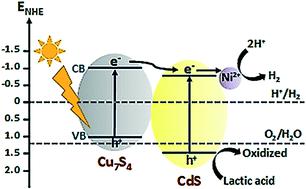当前位置:
X-MOL 学术
›
Catal. Sci. Technol.
›
论文详情
Our official English website, www.x-mol.net, welcomes your feedback! (Note: you will need to create a separate account there.)
In situ addition of Ni salt onto a skeletal Cu7S4 integrated CdS nanorod photocatalyst for efficient production of H2 under solar light irradiation
Catalysis Science & Technology ( IF 5 ) Pub Date : 2020-03-03 , DOI: 10.1039/c9cy02612f P. Bhavani 1, 2, 3, 4 , D. Praveen Kumar 1, 2, 3, 4 , Hyung Seop Shim 1, 4, 5, 6 , Putta Rangappa 1, 2, 3, 4 , Madhusudana Gopannagari 1, 2, 3, 4 , D. Amaranatha Reddy 1, 2, 3, 4 , Jae Kyu Song 1, 4, 5, 6 , Tae Kyu Kim 1, 2, 3, 4
Catalysis Science & Technology ( IF 5 ) Pub Date : 2020-03-03 , DOI: 10.1039/c9cy02612f P. Bhavani 1, 2, 3, 4 , D. Praveen Kumar 1, 2, 3, 4 , Hyung Seop Shim 1, 4, 5, 6 , Putta Rangappa 1, 2, 3, 4 , Madhusudana Gopannagari 1, 2, 3, 4 , D. Amaranatha Reddy 1, 2, 3, 4 , Jae Kyu Song 1, 4, 5, 6 , Tae Kyu Kim 1, 2, 3, 4
Affiliation

|
Development of earth-abundant, low cost, skeletal-type copper sulfide superstructures plays a prominent role in various potential applications, owing to the properties of superstructures such as excellent permeability of charge and mass. In this study, we synthesized hollow superstructures of crystallinity-controlled polyhedral skeletal-type copper sulfide (Cu7S4), which were integrated with cadmium sulfide (CdS) nanorods. The photocatalytic hydrogen production by water splitting was investigated under solar light irradiation with lactic acid as a hole scavenger. The Cu7S4/CdS composite exhibited a H2 production rate of 6.25 μmol h−1, which was 3 times higher than that of CdS. Moreover, the addition of a small amount of nickel salts to the reaction solution significantly improved the activity of Cu7S4/CdS for H2 production (45 μmol h−1), which was 20 times higher than that of CdS and 7 times higher than that of Cu7S4/CdS. The enhancement of activity in Ni–Cu7S4/CdS (Cu7S4/CdS with Ni salts in the reaction solution) was attributed to the effective separation of charge carriers due to the unique properties of the skeletal-type Cu7S4 cages and the superior charge transportation of Ni salts in the reaction solution. The Cu7S4/CdS system containing Ni salts in the reaction solution is reported for photocatalytic hydrogen production for the first time, to the best of our knowledge, which promises new and inspiring research for the development of photocatalytic water splitting applications.
中文翻译:

将镍盐原位添加到骨架的Cu7S4集成CdS纳米棒光催化剂上,以在太阳光照射下高效生产H2
由于上层结构的特性(如优异的电荷渗透性和质量),开发出富含地球,低成本的骨架型硫化铜上层结构在各种潜在应用中起着重要作用。在这项研究中,我们合成了结晶度可控的多面体骨架型硫化铜(Cu 7 S 4)的空心上层结构,并与硫化镉(CdS)纳米棒整合在一起。在以乳酸为空穴清除剂的太阳光照射下,研究了通过水分解产生的光催化制氢。Cu 7 S 4 / CdS复合材料的H 2产生速率为6.25μmolh -1,是CdS的3倍。此外,向反应溶液中添加少量镍盐可显着提高Cu 7 S 4 / CdS产生H 2的活性(45μmolh -1),比CdS高20倍,而CdS高7倍。高于Cu 7 S 4 / CdS。活性的镍-铜增强7小号4 / CDS(铜7小号4与反应溶液的Ni盐/ CDS)归因于载流子的有效的分离,由于骨架型Cu的独特性质7小号4笼和反应溶液中镍盐的优异电荷传输。据我们所知,首次报道了反应溶液中含有镍盐的Cu 7 S 4 / CdS系统用于光催化制氢,这有望为光催化水分解应用的发展提供新的启发性研究。
更新日期:2020-03-03
中文翻译:

将镍盐原位添加到骨架的Cu7S4集成CdS纳米棒光催化剂上,以在太阳光照射下高效生产H2
由于上层结构的特性(如优异的电荷渗透性和质量),开发出富含地球,低成本的骨架型硫化铜上层结构在各种潜在应用中起着重要作用。在这项研究中,我们合成了结晶度可控的多面体骨架型硫化铜(Cu 7 S 4)的空心上层结构,并与硫化镉(CdS)纳米棒整合在一起。在以乳酸为空穴清除剂的太阳光照射下,研究了通过水分解产生的光催化制氢。Cu 7 S 4 / CdS复合材料的H 2产生速率为6.25μmolh -1,是CdS的3倍。此外,向反应溶液中添加少量镍盐可显着提高Cu 7 S 4 / CdS产生H 2的活性(45μmolh -1),比CdS高20倍,而CdS高7倍。高于Cu 7 S 4 / CdS。活性的镍-铜增强7小号4 / CDS(铜7小号4与反应溶液的Ni盐/ CDS)归因于载流子的有效的分离,由于骨架型Cu的独特性质7小号4笼和反应溶液中镍盐的优异电荷传输。据我们所知,首次报道了反应溶液中含有镍盐的Cu 7 S 4 / CdS系统用于光催化制氢,这有望为光催化水分解应用的发展提供新的启发性研究。

























 京公网安备 11010802027423号
京公网安备 11010802027423号